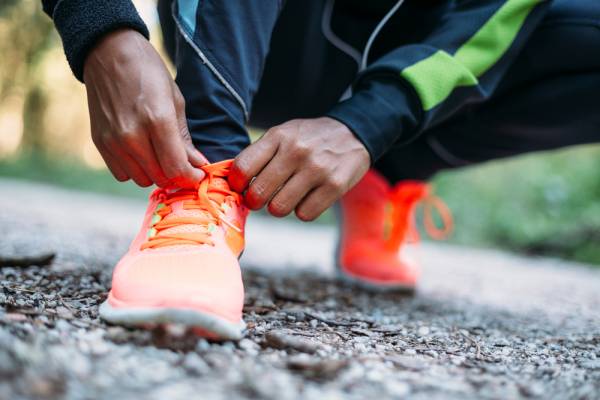Thanks to the publication of Born To Run, the concept of running shoe minimalism has become a mainstream fitness trend.
While the evolution of running shoes to minimal drop models is a massive positive for improving the way we run, it has also resulted in a big negative: an increase in running overuse injuries associated with the transition to minimalism.
In this article, I will give you the lowdown on the pros and cons of minimalism, as well as a step-by-step running plan to transition you to minimal shoes safely and without injury.
RELATED: What Forefoot Running Actually Means
Minimal Shoes Explained
For the uninitiated, minimalism is a catchall term referring to the redesign of shoes to create a more natural running experience. This is primarily done by reducing a shoe’s heel-toe drop (also called the heel-toe offset or heel-toe differential).
New Balance Minimus Hi-REZ zero drop shoe
The heel-toe drop is the difference between the midsole heel height (rear of the shoe) and the midsole forefoot height (front of the shoe). Thus, a 4mm drop shoe means when your foot is in the shoe, your heel will sit 4mm higher off the ground than your forefoot. A minimal drop shoe is generally classed as anything between 0-8mm.
RELATED: What You Need to Know About Buying Running Shoes
Pros of Running in Minimal Shoes
1. Noticeable Improvements in Biomechanics and Gait
The closer you are to zero drop, the closer you are to aligning your biomechanics and gait to the way nature intended for you to run. In particular, this tends to shift you into a more mid-foot or forefoot foot strike (as opposed to a heel strike), which can significantly reduce impact forces (read: likelihood of injury) and improve your running efficiency (see also point number four).
2. Less Restriction in the Ankles and Lower-Leg Tissues
The higher your heel-toe drop, the more you restrict range of motion in your ankles and lower-leg muscles. As running by nature involves thousands upon thousands of repetitions, your ankles and body will quickly adapt to this restricted range. Tight ankles and heel cords dramatically increase your likelihood of soft-tissue overuse injuries (e.g. Achilles tendonitis and plantar fasciitis).
“The higher your heel-toe drop, the more you restrict range of motion in your ankles and lower-leg muscles.”
3. Functional Strengthening of Lower-Leg and Foot Muscles
This is closely aligned with point number two. Running in minimal drop shoes forces the lower-leg and foot musculature to work harder by moving through a greater range of motion. The end result, if you transition to minimal shoes properly, is huge functional strength improvements in the lower-leg and foot muscles. This significantly reduces your injury risk, as well.
4. Improvements in Power and Economy
From my own experience, I have found the lightweight and more natural feel of minimal drop shoes noticeably improves my running power by reducing my ground contact time. It also improves my running economy by making it easier to maintain a higher cadence. For me, both of these variables noticeably degrade when I run in shoes with higher drops.
RELATED: The Pros and Cons of Barefoot Running
5. Better Ground Feel and Subjective Enjoyment
Nearly everyone who runs in minimal drop shoes will tell you they feel awesome on your feet and give you better ground feel. They make for a much more enjoyable running experience that makes it very hard to go back to a bulky higher-drop shoes.

Cons of Running in Minimal Shoes
The biggest con of running in minimal shoes is the significantly increased likelihood of injury if you don’t transition correctly. As highlighted earlier, running in minimal drop shoes forces your lower-leg and feet musculature to work harder by moving through a greater range of motion.
“The biggest con of running in minimal shoes is the significantly increased likelihood of injury if you don’t transition correctly.”
For those coming from a higher-drop shoe or who haven’t run before, this increased range of motion places huge stress on your feet and calves. This increased stress will lead to pain and injury unless you patiently add minimal drop loading and ensure you body has adapted before progressing.
The 12-Step Minimal Shoe Transition Plan (12MSTP)
What follows is a twelve-step running program I put together that will allow you transition smoothly into a more minimal shoe and/or barefoot running. Better still, it also works extremely well as a starting program for new runners or for those returning to running after a long lay-off.
As you will see, it incorporates the progressive use of run/walk efforts. While some running purists may consider that conservative, trust me when I tell you that transitioning to minimal drop shoes/barefoot is brutal on your lower limbs and you will be rewarded by adopting a patient approach.
RELATED: 2 Rules For Beginning Barefoot Running (And Avoiding Injury)
The Program
- 10mins (Run 1/Walk 1) x 5
- 15mins (Run 2/Walk 1) x 5
- 20mins (Run 3/Walk 1) x 5
- 25mins (Run 4/Walk 1) x 5
- 30mins (Run 8/Walk 2) x 3
- 35mins (Run 10/Walk 1:40) x 3
- 40mins (Run 12/Walk 1:20) x 3
- 45mins (Run 14/Walk 1) x 3
- 50mins (Run 15/Walk 1:40) x 3
- 55mins (Run 17/Walk 1:20) x 3
- 60mins (Run 19/Walk 1) x 3
- Run 60mins

The Rules
- You can either perform these sessions barefoot on the beach/soft grass or perform these sessions on the road/track in your preferred minimal shoe.
- Concentrate on practicing good running form during these sessions, with a particular focus on maintaining a leg cadence of 180-185 steps per minute.
- Only progress to the next run stage if you do not have any lower leg soreness in the 24-48 hours following the previous session. If you experience soreness, then you repeat the same stage the next time you run.
- If these are your only running sessions, do no more than three of these runs per week. If you are currently running three or more times per week, than substitute one of these sessions for every second run you do (e.g. Sunday transition session, Tuesday regular run in normal shoes, Thursday transition session, Saturday regular run)
- Don’t run on back-to-back days; always have at least one day between runs.
- Perform any non-transition runs in your regular non-minimal shoes.
- Either spend 10-15 minutes daily and/or at the end of every minimalist run working on the mobility of your ankle joint and the tissue quality/flexibility of your lower leg muscles (read gastrocnemius/soleus/tibialis anterior/plantar fascia).
- When choosing which minimal drop shoe to transition to, I recommend dropping no more than 4mm from your current shoe. So, if you currently run in 12mm drop shoes, transition to a 8mm drop. Once you have transitioned to your new minimal shoes, you can follow this program again to transition even lower.
- At the completion of the plan, you should be able to run in a more minimal shoe and/or barefoot for at least 60 minutes without soreness or injury. If you want to progress beyond 60 minutes in any one session, add cautious progression (10% per week). If you want to progress beyond 60 minutes for multiple sessions, I recommend you adopt this transition for each session you want to go minimal in.
RELATED: How to Reach Freak Level Fitness
Focus on the Long Game
At the minimum, this program will take four weeks to complete. For most, it will take between six to eight weeks. It will also require a fair degree of patience and humility. Remember, you have to focus on the long game. Going minimal is a means of improving your body’s natural function and your enjoyment of running for the rest of your life – not a quick-fix panacea to jump on a mainstream fitness trend.
Enjoy the process and let me know how you go. Please share your experiences with this program or any questions you have in the comments below.
Photo 1 “Gear of the Year 2013_Dr_naturalHealthStoreUS” by Carmen Rodriguez. Attribution 2.0 Generic License.
Photos 2 & 3 courtesy of Shutterstock.






